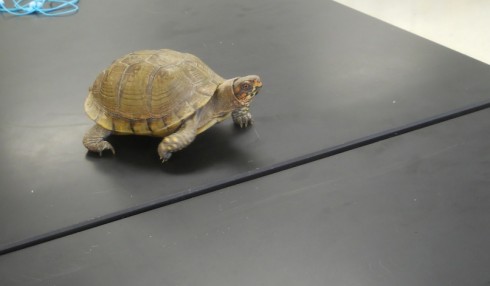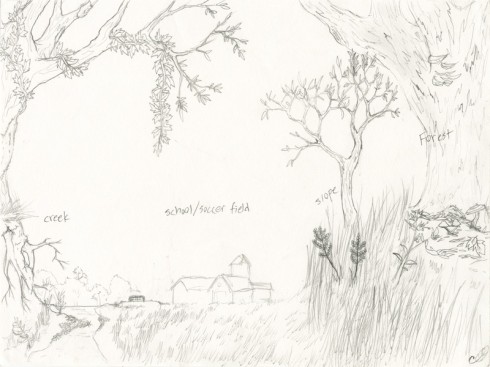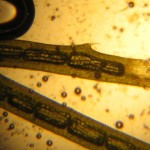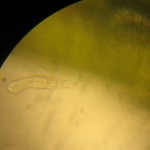
We have quite a number of box turtles on campus, but this visitor to biology class comes from Ms. M’s garden. You can tell the age by counting the rings on its shell. This guy is about 12 years old.
Middle and High School … from a Montessori Point of View
Unfortunately, the method of the demise of the worm-eating warbler that flew into our window appears to be more the rule than the exception. David Sibley (2010) calculates that windows are the number one, people-influenced, cause of death for birds.

Notice that cats are number two on the list.
A month in the spring can make a huge difference. Move your mouse over the image (or click the image) to see the difference between April and May on the Fulton School campus.
The full sized images can be seen here.
Note: To embed the image above use:
<iframe style=”overflow:hidden;” src=”http://earthsciweb.org/js/images/spring/spring.html” width=490 height=326 seamless />

I think that one of the reasons I really like this diagram is because it places the school as a small piece in a much larger ecological context. A student in my Environmental Science class drew it for an assignment. We’d hiked all the way from the creek to the ridge in the company of Scott Woodbury from the Shaw Nature Center, and I asked them to draw a diagram showing the different ecological regions. I’d expected top down maps, which is what almost all the other students did. When I asked why the perspective view, she said just didn’t know how to draw trees from the top down.
The impact of a change in the ecological conditions, like the introduction of the pesticide DDT, can cascade through an ecosystem with wierd and unexpected consequences. Richard Fagerlund explains:
In the 1950s, the World Health Organization sent supplies of DDT to Borneo to fight mosquitoes that spread malaria among the people. The mosquitoes were quickly wiped out. But billions of roaches lived in the villages, and they simply stored the DDT in their bodies.
One kind of animal that fed on the roaches was a small lizard. When these lizards ate the roaches, they also ate a lot of DDT. Instead of killing them, DDT only slowed them down. This made it easier for cats to catch the lizards, one of their favorite foods.
About the same time, people also found that hordes of caterpillars had moved in to feed on the roofing materials of their homes. They realized that the lizards that previously had kept the caterpillar population under control had been eaten by the cats. And now, all over North Borneo, cats that ate the lizards died from DDT poisoning. Then rats moved in because there were no cats to control their population. With the rats came a new danger: plague. Officials sent out emergency calls for cats. Cats were sent in by airplane and dropped by parachute to help control the rats.
— Fagerlund (2013): Take a lesson from Borneo — go easy on the bug spray on SFGate.com.

In January, the creek froze over after a few days of below zero (Celcius) temperatures. However, we’d missed the snow that usually accompanies a drop in temperature (it had hit to the south of us), so the ice froze clear and firm. Since they’re used to seeing the whiter ice — on lakes and ice rinks, for example — my students wondered why the ice was so clear.
In February, we got both the snow and cold, which incorporated air bubbles into the ice, resulting in a very different, cloudier ice.

It was quite neat to see the contrast, and made me wonder about the ecological impact. After all, clear ice lets sunlight through much more efficiently than cloudy ice.

While not quite as dramatic as drilling through four kilometers of ice to find signs of live in an Antarctic lake that’s been isolated from the rest of the world for over 100,000 years, we observed filamentous algae blooming under the clear ice on the creek earlier this winter.

I collected some of the algae and put it into the fish tank; I was hoping I could use it when we looked at plant cells because aquatic plants tend to have larger cells that are easier to see under the microscope.
However, one of my students is keeping tadpoles (also from the creek) in the fish tank. She noticed that the tadpoles were hanging out on top of the algae, and the algae was disappearing. Well, at least we’d solved her problem about what to feed the tadpoles.

While the filamentous algae might not be as good as the Egeria densa for plant-cell microscopy, it does host quite a number of other microbes that are fascinating to look at.
Based on these observations, ecologically the filamentous algae does not just provide habitat for protists and other microbes, it also appears to be a significant source of food for larger animals, like the tadpoles, and probably also the small fish that live in the creek.

Therefore, I’d hypothesize that in the winter, when the fish disappear, and most of animal life is quite subdued, the algae blooms because it’s not being grazed on nearly as much (see the picture above). When the weather warms, however, it’s the turn of the algae to repressed.
It would be interesting to have a student monitor the algae growth, and the fish/tadpole population, over the course of the school year to see if the relationship is more than just coincidence.
P.S. After our last snowfall, the melting snow has put a lot of water into the creek, and all the algae appears to have been washed away.